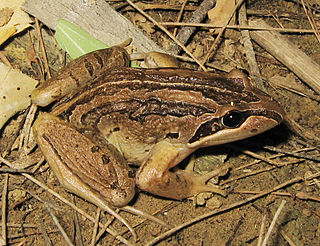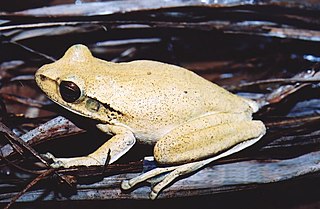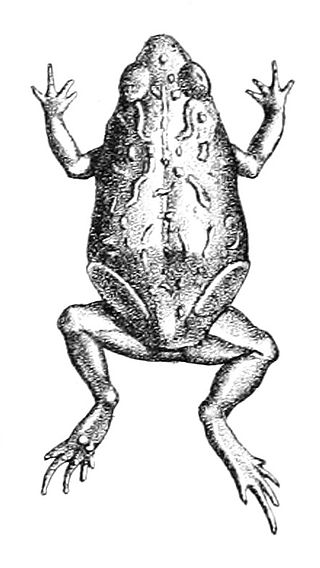
The striped marsh frog or brown-striped frog is a predominantly aquatic frog native to coastal Eastern Australia. It is a common species in urban habitats.

The red-crowned toadlet is a species of Australian ground frog, restricted to the Sydney Basin, New South Wales. It is only found around sandstone escarpment areas around Sydney, from Ourimbah in the north, Nowra to the south and the Blue Mountains areas to the west.

The striped burrowing frog is a species of burrowing frog in the subfamily Pelodryadinae of the family Hylidae. It occurs throughout much of Australia, from northern New South Wales, through eastern and northern Queensland and into eastern Northern Territory. This species was once included in the genus Litoria or Cyclorana.

The large toadlet or great toadlet or major toadlet is a species of ground-dwelling frog native to eastern Queensland and northern New South Wales, Australia.

The marbled frog or marbled marsh frog is a species of ground-dwelling frog native to northern and north-eastern Australia, and southern New Guinea in both Indonesia and Papua New Guinea.

Main's frog is a species of frog in the subfamily Pelodryadinae. It is endemic to western and central Australia. The frog is named after Professor Bert Main of the University of Western Australia, a pioneer of southern Western Australia frogs.

The Chaco tree frog is a frog species in the family Hylidae found in Argentina, Bolivia, Brazil, Colombia, French Guiana, Paraguay, and Venezuela.

The green-eyed treefrog is a species of Australasian treefrog in the subfamily Pelodryadinae that occurs in the Wet Tropics of Australia.

The bumpy rocket frog, also known as Peters' frog, is a species of frog in the subfamily Pelodryadinae. It is abundant and endemic to Australia, where it is found from northern Australia south to Maryborough, Queensland.

The Wotjulum frog is a species of frog in the subfamily Pelodryadinae. Its habitats are subtropical or tropical dry forests, subtropical or tropical moist lowland forests, subtropical or tropical swamps, rivers, intermittent rivers, swamps, freshwater lakes, freshwater marshes, intermittent freshwater marshes, and rocky areas.

Ranoidea wilcoxii, also known as the stony-creek frog, eastern stony creek frog, and Wilcox's frog, is a species of frog in the subfamily Pelodryadinae. It is endemic to Australia, being found solely on the eastern coast between Ingham, QLD, and Sydney, NSW, and as far west as Atherton, QLD. Its natural habitats are subtropical or tropical dry forests, subtropical or tropical moist lowland forests, rivers, intermittent rivers, and pastureland.
Hyperolius raveni is a species of frog in the family Hyperoliidae. Its natural habitats are rivers, freshwater marshes, and intermittent freshwater marshes.
Glauert's froglet, rattling froglet or clicking froglet is a species of frog in the family Myobatrachidae. It is endemic to Australia. Its natural habitats are temperate forests, rivers, intermittent rivers, shrub-dominated wetlands, swamps, freshwater lakes, freshwater marshes, arable land, pastureland, plantations, rural gardens, water storage areas, ponds, open excavations, sewage treatment areas, and introduced vegetation. It is threatened by habitat loss.

The magnificent brood frog or magnificent broodfrog is a species of frog in the family Myobatrachidae. It is endemic to Queensland, Australia, and is known from near Ravenshoe in the southern Atherton Tableland and from Mount Spec in the Paluma Range. The specific name covacevichae honours Jeanette Covacevich, an Australian herpetologist.

Dendy's toadlet is a species of frog in the family Myobatrachidae. It is endemic to Australia. Its natural habitats are temperate forests, temperate grassland, rivers, intermittent rivers, swamps, and intermittent freshwater marshes.
Douglas' toad is a species of frog in the family Myobatrachidae. It is endemic to Western Australia. Its natural habitats are dry savanna, moist savanna, subtropical or tropical dry shrubland, rivers, freshwater marshes, freshwater springs, and rocky areas.

Günther's toadlet is a species of frog in the family Myobatrachidae. It is endemic to Australia. Its natural habitats are temperate forests, temperate shrubland, Mediterranean-type shrubby vegetation, intermittent rivers, swamps, intermittent freshwater marshes, arable land, and pastureland.

The orange-crowned toadlet, or western toadlet, is a species of frog in the family Myobatrachidae. It is endemic to Australia. Its natural habitats are temperate shrubland, Mediterranean-type shrubby vegetation, intermittent rivers, intermittent freshwater lakes, freshwater marshes, intermittent freshwater marshes, and rocky areas.

Vaillant's frog is a species of frog in the family Ranidae found in Central America. Its natural habitats are subtropical or tropical dry forests, subtropical or tropical moist lowland forests, subtropical or tropical swamps, rivers, swamps, freshwater lakes, intermittent freshwater lakes, freshwater marshes, intermittent freshwater marshes, rural gardens, heavily degraded former forests, water storage areas, ponds, and canals and ditches.

The frilled tree frog, rough-armed tree frog, or Southeast Asian tree frog is a species of frog in the family Rhacophoridae found in Brunei, Cambodia, India, Indonesia, Malaysia, Myanmar, the Philippines, Thailand, and Vietnam. Its natural habitats are subtropical or tropical moist lowland forest, subtropical or tropical swamps, subtropical or tropical moist shrubland, rivers, swamps, freshwater marshes, and intermittent freshwater marshes. It is threatened by habitat loss.


















